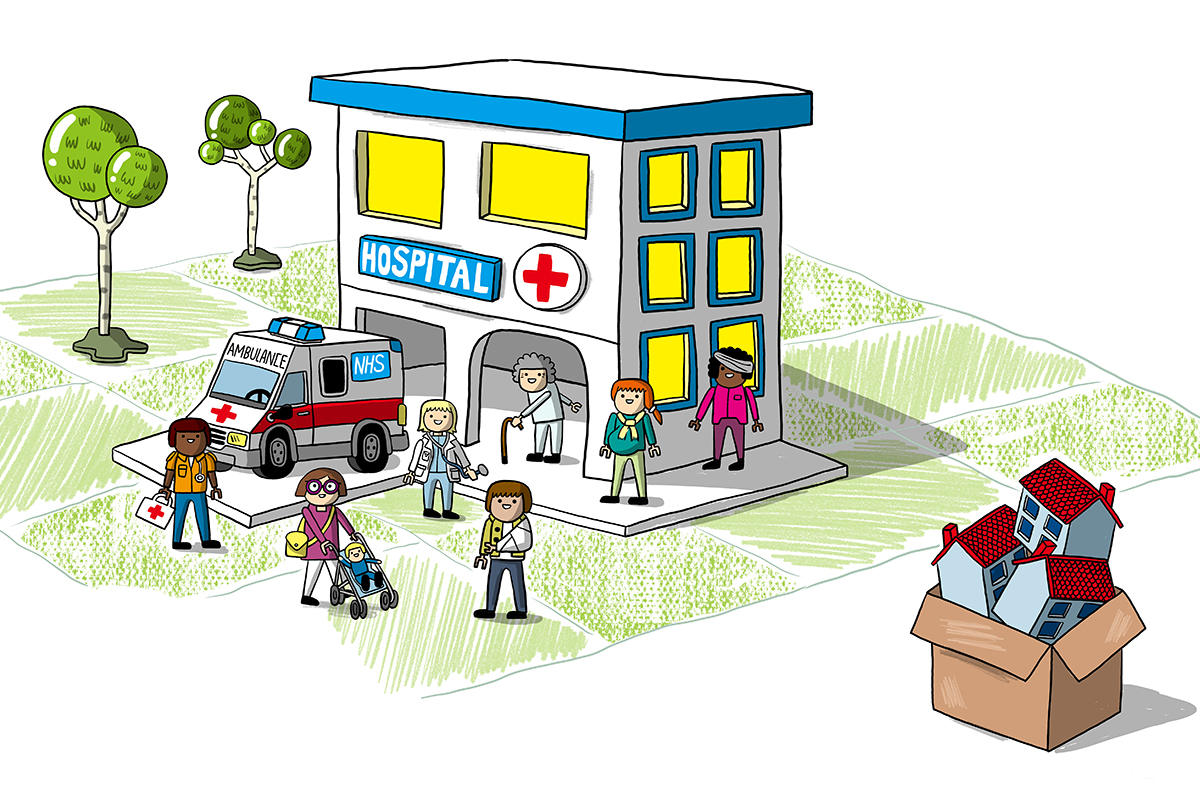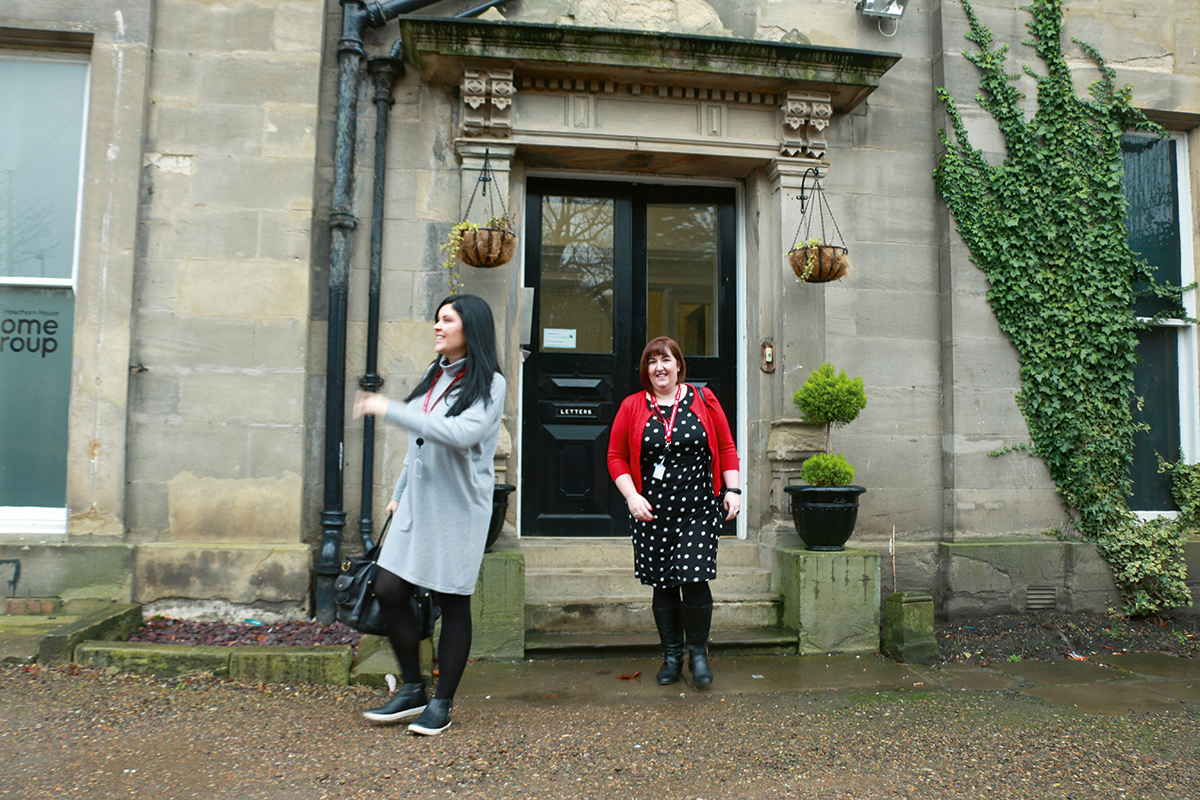You are viewing 1 of your 1 free articles
The health and housing game
Housing associations want to work with the NHS – but they often struggle to get plans out of the nursery. Sophie Barnes reports on how two landlords have managed to get noticed. Illustration by Tim Wesson
To understand how social landlords feel about their efforts to get involved in the NHS, think of the health service as a toy hospital.
Doctors, nurses, ambulances – everyone understands their role in a medical emergency. Toy houses, by contrast, barely seem to belong in the picture.
Social landlords believe they have a lot to offer the NHS – including how to help relieve some of the pressure on A&E, which in the past few weeks has prompted shocking headlines about paramedics queuing up to get their patients seen and doctors forced to treat serious cases in the hallways.
But persuading the NHS of these benefits, given the service’s traditional aversion to outside help, has been hard going. As Gill Moy, director of housing and customer services at Nottingham City Homes (NCH), puts it: “We have loads of toys to play with that we want to share with people, but we never get invited to the party.”
But as pressure on the NHS budget only seems to be getting worse, it is a good time to take a closer look at how some landlords have persevered and managed to set up projects that are helping to prevent A&E admissions and get patients out of hospital faster.
And to find out exactly how they’ve managed to win over the NHS.
Our search begins in Greater Manchester, where First Choice Homes Oldham (FCHO) runs four projects that involve joint working with health services in the area.
It has set up a ‘Hospital to Home’ discharge service in partnership with the Royal Oldham Hospital, Pennine Care NHS Foundation Trust and Oldham Council. A housing officer from FCHO is based at Royal Oldham Hospital and provides support to medical staff to prevent “delayed patient discharges” – where patients are stuck in hospital beds, often because of problems arranging medication, accommodation or care. For example, an older person may not be able to return home because they fall regularly and there are no support bars in their homes.
The housing officer can arrange for their home to be adapted so they can return and free up the hospital bed for another patient.
A pilot began in April 2016 and helped 92 patients to move home quickly; 26 of these patients were rehoused into accommodation that was more suitable for their needs, preventing repeat hospital visits. The local Clinical Commissioning Group (CCG) was impressed by the pilot and agreed to provide half the funding for the service – £20,000 – with FCHO providing the remaining half.
Kelly Webb, assistant director for health and housing needs at FCHO, says the service is now “really well established” within the discharge team at the hospital “and it’s an absolutely essential service”.
But she adds: “If we’re honest, initially when we established the hospital discharge service it was brand new and we had a lot to overcome – there was a lot to do around networking, understanding what we could bring to the table, how we could make a difference… and that wasn’t a quick win.”
"When we established the hospital discharge service it was brand new and we had a lot to overcome," Kelly Webb, FCHO
The biggest barrier for FCHO has been persuading NHS organisations to share medical information on patients. “We absolutely understand the need to maintain data protection around that but it’s trying to find ways that we can access some of the data for the benefit of all,” Ms Webb says. “There have been barriers around the sharing that we’re only just overcoming.”
To get around accessing medical information through the NHS, FCHO has to take the slightly long-winded approach of asking GPs to write to patients telling them the housing association will be in touch.
But the success of Hospital to Home has made it easier for the association to start other health projects because it had built a solid working relationship with the local hospital’s discharge service. In October 2017, the association started an ‘A&E to Home’ service at the same hospital, which deals with people who are regularly turning up at A&E with non-clinical issues, such as drug abuse or homelessness. Around 10 referrals every month have been directed to further community services such as an immigration advisory service, urgent care social workers or the local homelessness team.
Two other projects – Housing Options for Older People and Healthy Homes – are focused out in the community rather than in hospital and help to find older people suitable housing and care so they can live independently for as long as possible or to adapt their homes.
Getting that initial foot in the door was the tough bit, Ms Webb says, partly because of an understandable lack of awareness on health workers’ part about what a housing association can do to help them. “There’s maybe not an understanding of how we could help deal with some of their acute pressures because you don’t necessarily see housing as having a role to play in managing the pressures of A&E. You wouldn’t expect a nurse or a doctor in an A&E to understand the ins and outs of a housing association,” Ms Webb points out.
The pooling of health and social care budgets in Greater Manchester, a major part of the region’s devolution deal which resulted in a £6bn pot, has been a game changer, Ms Webb says. “There’s been a change in thinking. I think we’re working much more collaboratively with the 10 authorities within Greater Manchester and with our local social care services. We’re streets ahead. Two years ago we didn’t have a health [project] and now we’ve got four – it’s really kicked up a gear.”
Meanwhile, Nottingham City Homes has been valiantly trying to get joint working off the ground with Nottingham City Council’s adult social care team and local NHS organisations.
For NCH, the pitch to the NHS and social care revolved around the daily contact housing staff have with local people. Frontline staff see their residents regularly, so NCH argued it could identify early signs of illness and help connect people with services to stop them from deteriorating. Housing staff can also spot if a home needs to be adapted for the resident, making it more likely they can stay in their own home for longer.
All this could be of great use to the NHS and social care, housing leaders argue, because it could stop people from visiting A&E needlessly or ensure they can be discharged from hospital as soon as possible because they will have a home to go back to that has been adapted for them.
NCH recognised the role it could play in speeding up these discharges and sought a place at the table when it came to seeking solutions for some of the financial challenges health and social care face. The three sectors locally – the NHS, housing and adult social care, overseen by the local health and well-being board – signed a memorandum of understanding (MOU) in June 2016 pledging to work together to achieve better health outcomes for the community.
NCH’s memorandum of understanding with the NHS
The agreements in the memorandum of understanding:
- Developing efficient and innovative working practices where information is shared, joint working is carried out and funding opportunities are “maximised”
- Helping local partners to identify and carry out their role in homelessness prevention as well as meeting the health needs of homeless people
- Making sure homes in the private sector are safe, well managed and help to protect the health and well-being of residents
- Providing evidence for the need for integrated health, social care and housing work
- Developing the financial resilience of Nottingham citizens
First, the group came up with five priority areas for the MOU. This joint working fed into a high-priority NHS project that was underway nationally in 2016 – the creation of sustainability and transformation plans (STPs). These are required by NHS England and set out a five-year vision to improve care and the efficiency of health services in an area.
As a result of NCH’s seat at the table, the Nottingham and Nottinghamshire STP is now one of the few in the country that includes housing in its plans for the future. Specifically, it states that social landlords will provide “better support” to help people to be discharged from hospital “safely and at the right time” by making sure their accommodation is safe and appropriate to return to.
But despite this high-profile role for housing, the joint work has hardly been plain sailing. “Largely the frustrations are due to some of the financial pressures that we find colleagues in adult social care and health are facing,” says Ms Moy. “We’re starting to see some pressures build up on that for the next financial year. Budgets are reducing drastically but you’ve got more people living longer, more people who need services at a time when budgets are dropping.”
This pressure on the health service’s time is also apparent when Inside Housing tries to find someone from the local NHS to talk to about joint working with housing. After several attempts it’s clear we won’t be able to hear from the health service’s side.
“From the housing point of view we’ve got so much to offer the health and social care agenda", Gill Moy, Nottingham City Homes
This constant firefighting by health and social care leaders means their focus has not been on longer-term solutions that could result in savings.
“From the housing point of view we’ve got so much to offer the health and social care agenda and being part of that wider integrated workforce, but they’ve got so many budgetary pressures that they’re having to make decisions based on short-term savings – probably to the detriment of some of the longer-term savings that working with housing can actually bring,” Ms Moy says.
It has also been difficult to communicate to some health workers the value of housing, when their day-to-day focus is on acute medical need.
NCH is running a ‘Hospital at Home’ project which aims to keep vulnerable residents out of hospital and is now seeking to place a member of staff in the local hospital to help them discharge patients, funded by the local CCG. The project has delivered savings of £930,000 between November 2015 and March 2017. The lion’s share of savings have been made by the NHS, with £482,100 saved through patients not having to be readmitted to hospital.
Ms Moy is pleased with the relationships NCH has developed with healthcare professionals but she says what is exercising everybody is how the work can be financed in the future. Currently, the CCG is stumping up the cash but beyond March NCH needs to find a new funding source, something it is currently looking into.
But Ms Moy is determined to keep going. “I very much do believe housing has a heck of a lot to offer the health and well-being world and adult social care, so it’s really important we persevere despite all the financial pressures that are on us.”











